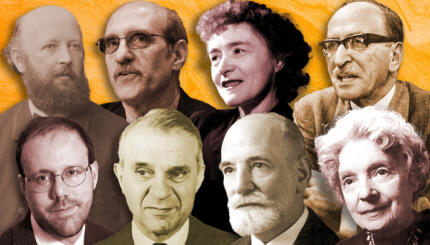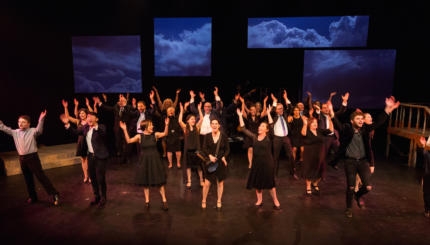Jewish literature in Europe can be divided into two broad categories: literature written in traditional Jewish languages–like Yiddish, Hebrew, and Ladino — and literature written in the language of the country the writer happened to live in. Because many Jewish writers wrote in German, Russian, French, and other European languages, what we call “European Jewish literature” overlaps with European literature as a whole. Franz Kafka and Isaac Babel can be counted as “Jewish writers” and also, of course, “major European writers.”
Since Jewish writers write in so many languages, any attempts to construct a “modern Jewish canon” — such as the landmark effort in 2001 by leading scholars including Harvard’s Ruth Wisse and the Hebrew University’s Gershon Shaked to draw up a list of 100 Great Jewish Books — tend to be incredibly multilingual lists. The Great Books list, released by the National Yiddish Book Center, and Wisse’s book The Modern Jewish Canon discuss works in Yiddish, Hebrew, English, Russian, French, Dutch, Polish and Czech.
The number of translations available into English is increasing. For an understanding of shtetl (village) life, the Yiddish short-story writers are an excellent place to begin. Sholom Aleichem, I.L. Peretz, and Mendele Mocher Seforim preserved a world of mostly poverty-stricken Jews struggling to survive and believe in whatever they could. These stories include hapless characters like the beggars of Kasrilivke and the fools of Chelm. The humor and the fantastical touches of these writers can be seen in Poland-born Isaac Bashevis Singer, who won the Nobel Prize, and whose work has been widely translated into English. Singer writes of golems, imaginary spirits, and old-world characters.
But European Jewish literature in Jewish languages is not all golems and goblins. The Russian-born Hebrew poets Chaim Nachman Bialik and Saul Tchernichovsky, both writing in the late 1800s and early 1900s, laid the foundation for modern Israeli literature, and both wrote of the land, love, Zionism, and faith. Of course, the medieval Hebrew poems written in Europe can be found in the mahzor (High Holiday liturgy) and the siddur (prayer book), and are part of the daily lives of Jews around the world, and preserve a sense of belief despite the travails of Jewish history.
When it comes to Ladino literature, scholar Ilan Stavans, writing in The Forward, observed that because the Jews of the Iberian peninsula were expelled, Sephardic writing was more overtly religious and philosophical than purely fictional for quite some time. The best-known example of rabbinic literature in Ladino is Me’am Loez, the 18th- and 19th-century commentary on the Bible. The period of Me’am Loez was the first major flowering of Ladino, and a second productive period occurred in the early 20th century, when journalism and pamphleteering gave many writers a chance to be published. Unfortunately, the Holocaust ended this flowering.
After the devastation of the Holocaust, Yiddish and Ladino were suddenly in the same spot, with the few surviving speakers clutching to a centuries-old literature and hoping that a younger generation might become interested in it.
But in recent years, efforts to preserve Yiddish and Ladino have paid off, and attempts to translate their literatures into English and Hebrew have brought them new readers. The Yiddish stories have influenced the writing of American fiction writers like Bernard Malamud, Saul Bellow and Nathan Englander. Meanwhile, Ladino’s fantastical stories — sometimes called fables or folk tales — are finding their way into Spanish. These stories often have Jewish themes, with biblical figures and legendary characters. They sometimes offer interpretations on traditional aspects of Jewish wisdom, like the need to be satisfied with what one has. Though they usually don’t have a particular author, they do tend to share a sweet sense of humor, an interest in Jewish ideas, and a determination to look at a common situation in a new way.
Just as the Yiddish short stories often feature Herschel, a hapless fool, or a town golem, or village idiot, so the Ladino stories feature Jocha, who is either a sneaky trickster or a very dumb local. Like the Yiddish stories, Ladino writers tend to emphasize the need to be happy with one’s lot, the wisdom of considering another perspective, and the joy that is still possible despite poverty, discrimination, and persecution. This message seems especially poignant when delivered in the traditional Jewish languages of Europe. For Yiddish and Ladino as languages and literatures, survival has been possible through travel and translation–despite the immense obstacles of history and exile.
Sephardic
Pronounced: seh-FAR-dik, Origin: Hebrew, describing Jews descending from the Jews of Spain.
Mahzor
Pronounced: MAKH-zore, Origin: Hebrew, literally “cycle” the mahzor is the special prayer book for the High Holidays, containing all the liturgy for Rosh Hashanah and Yom Kippur.
siddur
Pronounced: SIDD-ur or seeDORE, Origin: Hebrew, prayerbook.



